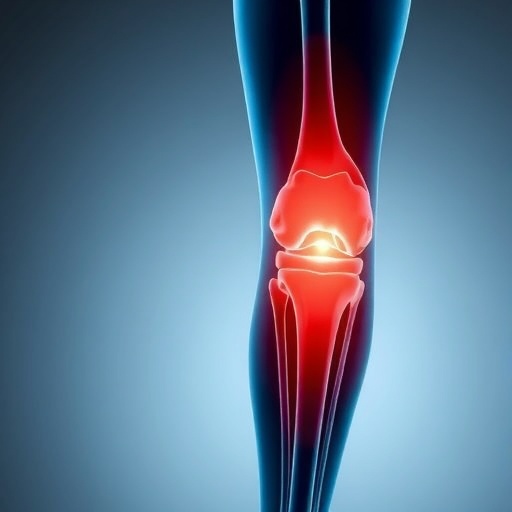In recent years, the integration of technology into the medical field has revolutionized patient care, particularly for those undergoing surgical procedures such as knee arthroplasty. A groundbreaking study led by researchers Yeung, Yang, and Yeung presents an innovative approach to enhancing the assessment of patient outcomes using Inertial Measurement Units (IMUs). This novel technique aims to leverage advanced sensor technology to provide more nuanced, real-time measurements of patients’ rehabilitative progress and quality of life following knee surgery. The study details these remarkable advances, highlighting the potential for greater diagnostic accuracy and improved patient engagement.
Knee arthroplasty, a procedure commonly performed on individuals suffering from osteoarthritis and other joint-related ailments, addresses knee pain and mobility issues. As the demand for this surgery continues to rise, the quest for effective postoperative evaluation methods grows increasingly critical. Traditional Patient-Reported Outcome Measures (PROMs) have long been the gold standard in evaluating patient recovery and satisfaction. However, these measures often rely on subjective reporting and can be influenced by various biases and errors. Yeung and colleagues identified the need for a more objective and precise method to enhance the quality of rehabilitation outcomes.
The IMU-augmented PROM system introduced by these researchers is a pioneering blend of sensor technology and patient self-reporting. IMUs are compact devices that utilize accelerometers, gyroscopes, and magnetometers to capture movement data in three-dimensional space. By integrating this technology into the rehabilitation process, healthcare providers can gain valuable insights into a patient’s physical performance, including their gait, stability, and strength. The data collected from these sensors can be analyzed alongside PROM responses, offering a comprehensive picture of recovery.
One of the most compelling aspects of the IMU system is its potential to promote patient adherence to rehabilitation protocols. With real-time feedback, patients become more aware of their performance and progress, motivating them to engage fully in their recovery. The study by Yeung et al. reveals that when patients are given concrete data regarding their performance, they are more likely to participate actively in their rehabilitation, ultimately leading to improved outcomes.
In addition to improving adherence, the use of IMUs allows for the identification of specific areas needing attention during recovery. Traditional PROMs may overlook subtle aspects of rehabilitation that could significantly impact a patient’s long-term recovery. By continuously monitoring movement patterns and physical capabilities, the IMU system can reveal trends and changes, helping clinicians tailor rehabilitation programs to address individual patient needs. This personalized approach marks a significant shift in how post-surgical rehabilitation is conceptualized and implemented.
Research conducted by the team indicates that the IMU-augmented approach yields superior results compared to traditional PROMs alone. They found that patients utilizing this system exhibited higher rates of satisfaction and reported feeling more empowered in their recovery process. This empowerment stems from the continuous, objective data provided by the IMU, fostering a sense of ownership over their rehabilitation journey.
Moreover, the IMU system generates valuable data for clinicians, enabling them to make informed decisions about treatment adjustments. Clinicians can track a patient’s progress more accurately, identifying when a patient is not meeting expected benchmarks and intervening earlier to address potential issues. This capability enhances the overall effectiveness of postoperative care, ensuring that patients receive optimal guidance tailored to their unique recovery pathways.
The implications of this research extend beyond just knee arthroplasty patients. The technology and methods developed in this study could easily be adapted for use in other surgical procedures and rehabilitation contexts, such as hip replacements or sports-related injuries. The versatility of IMUs means that a broader population could benefit from this enhanced monitoring and evaluation technique, potentially transforming the landscape of recovery and rehabilitation in orthopedics and beyond.
Furthermore, as technology continues to evolve, the integration of advanced data analytics and artificial intelligence could revolutionize how data from IMUs is processed and interpreted. Future iterations of this system could harness machine learning algorithms to predict patient outcomes with even greater accuracy, enabling clinicians to intervene proactively and refine therapy protocols continuously.
The research conducted by Yeung and colleagues opens the door to a new era of evidence-based rehabilitation involving technology-enhanced patient engagement and outcome measures. This IMU-augmented PROM system not only enhances clinical assessment but also empowers patients to take an active role in their recovery. By providing real-time data and fostering a collaborative environment between patients and healthcare providers, the system has the potential to drastically improve postoperative care and overall patient satisfaction.
In conclusion, the study led by Yeung et al. heralds a significant advance in the field of orthopedic rehabilitation. By marrying sophisticated sensor technology with patient-centered care approaches, this research promises to not only elevate the standards of postoperative evaluation but also enhance the quality of life for knee arthroplasty patients. As healthcare continues to embrace new technologies, the future holds great promise for improved recovery pathways and better overall health outcomes for patients undergoing surgery.
Subject of Research: IMU-augmented Patient-related Outcome Measure for Knee Arthroplasty Patients
Article Title: IMU-augmented Patient-related Outcome Measure for Knee Arthroplasty Patients
Article References:
Yeung, T., Yang, S., Yeung, S. et al. IMU-augmented Patient-related Outcome Measure for Knee Arthroplasty Patients.
J. Med. Biol. Eng. (2025). https://doi.org/10.1007/s40846-025-00974-z
Image Credits: AI Generated
DOI: 10.1007/s40846-025-00974-z
Keywords: IMU, knee arthroplasty, Patient-Reported Outcome Measures, rehabilitation, technology in healthcare.




